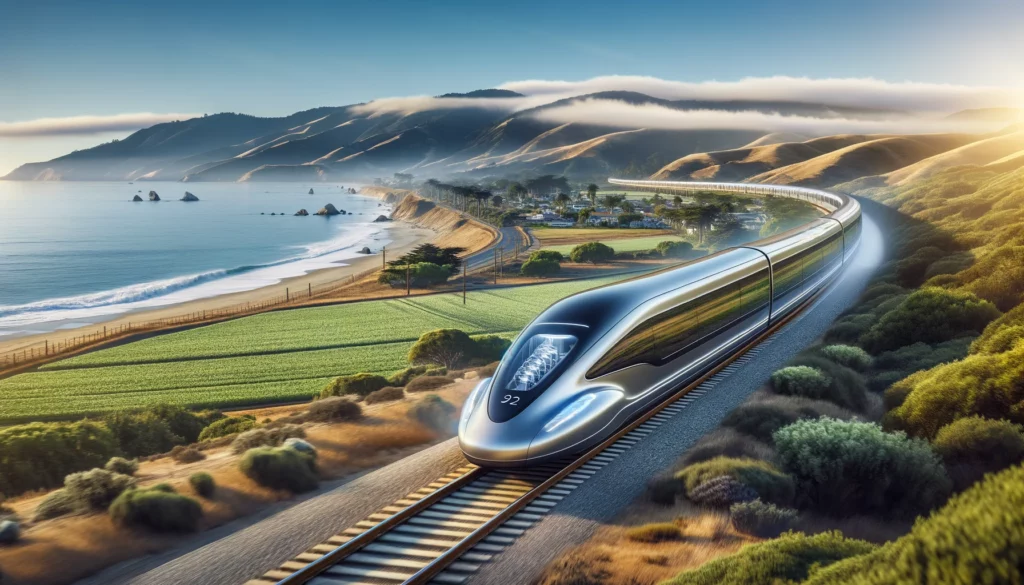The California Department of Transportation (Caltrans) has expanded its investment in sustainable transportation by ordering six additional hydrogen-powered passenger trains from Stadler Rail, with a total investment of $127 million. This order builds upon a previous commitment in 2023 for four hydrogen trains, aiming for these new additions to be operational by 2027.
Stadler’s Hydrogen Trains
Developed around Stadler’s Fast Light Intercity and Regional Train (FLIRT) model, these hydrogen trains are designed to be more efficient, lightweight, and cost-effective than traditional locomotive-hauled coaches. The FLIRT H2 model, first ordered in 2019, boasts a top speed of 79mph and features a unique composition with two cars and a central power pack containing the fuel cells and hydrogen storage, capable of seating 108 passengers.
Hydrogen Trains in California’s Central Valley
These pioneering trains are slated to begin service between Merced and Sacramento as part of the forthcoming Valley Rail service and Amtrak San Joaquíns, eventually linking with California’s inaugural high-speed rail segment. Additionally, the trains will undergo testing across various California routes in partnership with intercity and regional rail operators.
With a total of 10 hydrogen trains now on order and an option for 19 more under the original contract signed with Stadler in October 2023, California is reinforcing its commitment to innovative and eco-friendly transportation solutions. Toks Omishakin, the state’s Transportation Secretary, emphasized this move as a testament to California’s dedication to pioneering sustainable transit options.
California’s foray into hydrogen-powered trains marks a significant milestone in the state’s journey towards sustainable public transportation. By integrating hydrogen fuel cell technology into its rail systems, California is setting a precedent for clean, efficient, and innovative transit solutions. These trains, which emit only water vapor as a byproduct, represent a leap forward in reducing greenhouse gas emissions and dependency on fossil fuels. The initiative is part of California’s broader commitment to environmental sustainability and its $10 billion zero-emission vehicle plan. Operating on routes such as those between Merced and Sacramento, these hydrogen trains not only promise to enhance the passenger experience with quieter and smoother rides but also bolster California’s standing as a leader in the adoption of green technology. This move aligns with the state’s goals of curbing air pollution and fostering a sustainable future, showcasing a proactive approach to tackling climate change through advanced transportation technologies.
About California’s Zero-emission Vehicle Initiative
Funded through California’s ambitious $10 billion zero-emission vehicle initiative, which allocates $407 million for the California State Transportation Agency (CalSTA) to acquire or lease clean bus and rail equipment, this expansion underscores the state’s proactive approach to reducing carbon emissions and promoting green transportation technologies, particularly through the adoption of hydrogen trains.
California’s $10 billion zero-emission vehicle initiative stands as a testament to the state’s commitment to environmental sustainability and innovation in transportation. Launched as part of a broader strategy to combat climate change and reduce greenhouse gas emissions, this comprehensive program aims to accelerate the adoption of zero-emission vehicles (ZEVs) across the state. By funding the development and deployment of electric and hydrogen-powered vehicles, including cars, buses, and trains, California seeks to lead the way in creating a cleaner, greener transportation future. The initiative not only focuses on increasing the number of ZEVs on the road but also invests in the necessary infrastructure, such as charging stations and hydrogen fueling facilities, to support this transition. This forward-thinking approach underscores California’s role as a global leader in environmental policy and sustainable development, aiming to significantly reduce the state’s carbon footprint and set a benchmark for others to follow.
About Stadler’s Hydrogen Trains
Stadler’s Fast Light Intercity and Regional Train (FLIRT) represents a significant advancement in the field of rail transportation, characterized by its adaptability, efficiency, and comfort. The inception of the FLIRT dates back to the late 1990s, with the objective of creating a versatile train capable of catering to both regional and intercity routes. The first FLIRT made its debut in 2004, quickly setting a new standard for passenger rail service. Its modular design allows for a wide range of configurations, enabling operators to customize the trains to fit specific route requirements and passenger capacities. Over the years, Stadler has refined the FLIRT’s design, integrating the latest technological advancements to enhance performance, passenger experience, and environmental sustainability. This continuous innovation has expanded the FLIRT’s presence globally, with numerous rail operators adopting the platform for its reliability and operational efficiency.
About Stadler’s Technology
Stadler Rail AG, the company behind the FLIRT, is headquartered in Bussnang, Switzerland, and has established itself as a leading player in the rail vehicle industry. The Swiss company draws upon the country’s rich heritage in precision engineering and a strong culture of innovation to develop its state-of-the-art rail solutions. Stadler’s approach to train manufacturing emphasizes flexibility, energy efficiency, and sustainability, principles that are deeply embedded in Swiss technological advancements. The introduction of the hydrogen-powered FLIRT H2 model underscores Stadler’s commitment to pushing the boundaries of rail technology, making it a pioneer in the development of clean and green transportation solutions. By leveraging its Swiss roots and a relentless focus on innovation, Stadler continues to shape the future of rail transport, delivering trains that meet the evolving needs of global transit systems and contribute to the reduction of the industry’s carbon footprint.
FOLLOW THIS LINK TO LEARN MORE: https://www.h2-view.com/story/california-orders-six-stadler-hydrogen-powered-trains-for-127m/2106178.article/





